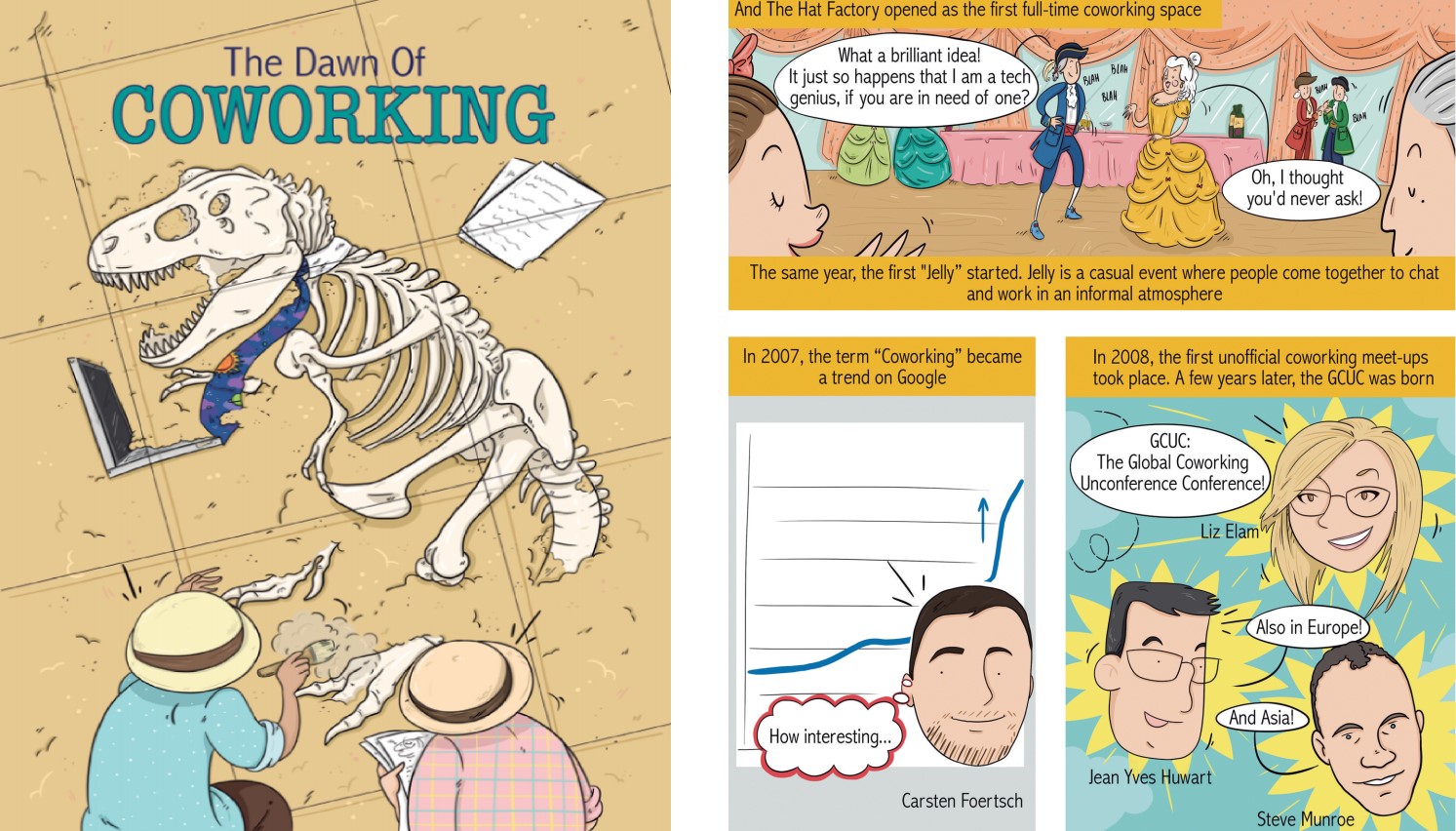The Dawn of Coworking
We have been lucky to see the evolution of the coworking movement, from being a niche industry, to becoming mainstream. Coworking offers flexibility, freedom, and an opportunity to collaborate and network with other professionals - so it’s no surprise that the concept has become so popular. But when and how did this phenomenon come about?
We have teamed up with Sara Jotabé, cartoonist and illustrator, to create a comic book to illustrate the history of coworking!
A summary of ‘The Dawn of Coworking’
A long time ago in a galaxy far, far away....Well actually, it was 1995, in Berlin - C-base, one of the first hackerspaces in the world, opened. Hackerspaces are community-oriented, and a place where people with similar interests can meet and work. Hackerspaces are considered as some of the first pre-models of coworking spaces.
In 1999, Bernard Dekoven coined the term ‘coworking’ as a new working method to support collaboration, whilst giving people the opportunity to work on their own projects, i.e. “Working together as equals”. Shared, flexible workspaces were starting to appear, but the community aspect of coworking was still missing.
In 2005, Brad Neuberg opened the first official coworking space in San Francisco…the first of many coworking spaces to come.
In 2006, the first “Jelly” started, which is a casual event where people come together to chat and work in an informal atmosphere.

In 2008, the first unofficial coworking meetups took place. In 2010, the first coworking conference took place at the Hub in Brussels, and a couple of years later, GCUC was born.
Books about coworking were starting to be published and the word was spreading. Coworking was now a popular concept in the USA and Europe.
In 2012, there were more than two thousand coworking spaces worldwide, which grew to over three thousand by the start of 2013.
.jpg)
Today, in 2018, there are more than 14,411 coworking spaces in the world. Technological advances are allowing more workers to be on the move, and consequently, the demand for innovative flexible workspaces with a strong community, and a network of support is growing rapidly.
That’s all, folks! We will continue this exciting history lesson in our next comics in which we will cover trends that are changing the coworking world.
If you would like a copy of our ‘The Dawn of Coworking’ comic book, contact us now!
.jpg)
The history of coworking source: Deskmag
Related stories
Liz Elam: ‘Community is the number one amenity in coworking spaces’
A household name in the global coworking industry, Liz Elam, is the founder of one of the world’s best coworking event series: GCUC. Liz’s coworking roots began in 2010, when she established Link Coworking – a welcoming, affordable, and professional coworking space – in her hometown of Austin, Texas. Link Coworking achieved incredible success, expanding across three locations and becoming the fourth-largest coworking brand in Austin. It was sold in 2019, making Liz the first woman globally to exit a coworking brand.
How to Make Your Coworking Space More Sustainable in 2025
Sustainability is becoming more and more important for coworking spaces. If you're thinking of making your space more sustainable, it's good to remember that there are lots of ways to go about it. From small details to bigger changes, everything adds up when it comes to reducing your environmental impact.
Key Takeaways from the Coworking Alliance Summit 2025
Gathering online for the Coworking Alliance Summit last week, members of global coworking alliances, coworking spaces, and community leaders came together to navigate global issues, strengthen ties across the coworking industry, and work collectively towards future goals.
5 Ways to Reduce Noise in Open Offices & Coworking Spaces
Some people like working against a background of noise, while for others it’s their worst work nightmare. The truth is, our relationship with noise depends on our own preferences and the nature of our work.
ViDA Compliance Guide: 8 Essential Steps for Coworking Spaces in the EU
Now that 2025 has arrived, the European Union's VAT in the Digital Age (ViDA) initiative is becoming a key topic for coworking spaces operating in the EU. But don’t panic—ViDA will be introduced gradually, with key changes taking effect from 2028. This major VAT reform aims to modernize tax reporting, combat fraud, and streamline compliance through mandatory e-invoicing and real-time digital VAT reporting for certain transactions.
Key takeaways from the Workspace Design Show 2025
London’s Workspace Design Show is undoubtedly one of the best coworking events of 2025. For one, the exhibition (held at Islington’s Business Design Centre) features a host of innovative and creative workspace design solutions tailored to the needs of modern workplaces.
Harnessing AI to Help Coworking Operators Understand Their Communities Better
After more than twelve years in the coworking industry, we’ve seen the movement evolve at an incredible pace, especially in recent years. Spaces have grown larger, making it harder for operators to truly connect with their communities. At the same time, expectations for higher service standards and increasing competition mean that creating tailored experiences and fostering long-term member engagement is more important than ever.
What Is Workplace Management and Why Does It Matter?
There has always been a need for workplace management – the process of organising and optimising physical spaces, resources, and operations to support people’s needs. But, as 28% of UK working adults were reported to work in a hybrid capacity last autumn (by the Office for National Statistics), the question of ‘why workplace management matters’ is more critical than ever. Let’s look at the workplace management benefits for your operations.
10 Smart Goals for your Coworking Space: How to Set & Achieve Business Objectives
Coworking is synonymous with creativity, collaboration and productivity. Businesses and freelancers love coworking spaces because (by surrounding themselves with fellow workers) they’re more likely to achieve their goals. The coworking environment, while social, is set up to facilitate focused, distraction-free working.
The Best Coworking Events in 2025: Must-Attend Gatherings for Professionals
Managing coworking spaces is an all-encompassing role, often leaving operators, owners, and community managers with little time to focus on personal growth or draw inspiration from others.

